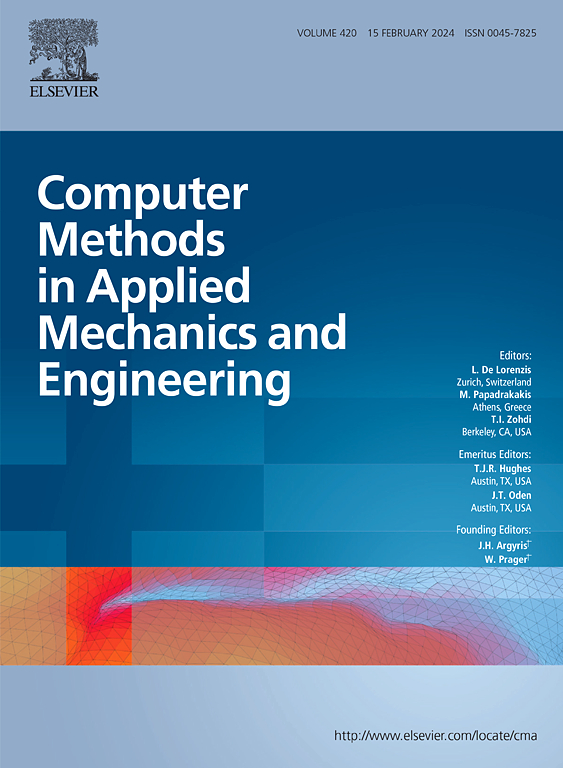PIGODE: A novel model for efficient surrogate modeling in complex geometric structures
IF 6.9
1区 工程技术
Q1 ENGINEERING, MULTIDISCIPLINARY
Computer Methods in Applied Mechanics and Engineering
Pub Date : 2025-03-29
DOI:10.1016/j.cma.2025.117930
引用次数: 0
Abstract
Physics-Informed Neural Network (PINN), as a novel neural network model, is known for its strong interpretability and generalization capabilities, making it widely used in surrogate models and various engineering scenarios. While traditional PINN has achieved good results in simple geometric scenarios, there is limited research on its application to complex geometric structures. Additionally, PINN integrates boundary conditions into the loss function, requiring retraining model when boundary conditions change. To address these issues, we propose a new Physics-Informed Graph Ordinary Differential Equation (PIGODE) model for constructing surrogate models in complex geometric structures. The Peridynamic Differential Operator (PDDO) is extended to a PIGODE which is defined on graph data structure, and a PDDO-based message passing layer is developed to replace automatic differentiation (AD). This method precomputes Peridynamic weights, thereby avoiding additional computational overhead during model training. Furthermore, boundary conditions are embedded into the model input to address the need for dynamically modifying boundary conditions in surrogate models. Through comparative studies with existing PINN solvers, we validate the effectiveness of the proposed model, demonstrating its superior performance on complex geometric structures. Additionally, this model is applied to practical engineering scenarios, specifically constructing a temperature field surrogate model for the conical picks of a tunnel boring machine. The research results indicate that the proposed PIGODE model not only enhances the interpretability and efficiency of surrogate models but also extends their applicability to complex geometric structures in engineering.
PIGODE:一种在复杂几何结构中高效代理建模的新模型
物理信息神经网络(physical - informed Neural Network, PINN)作为一种新型的神经网络模型,以其强大的可解释性和泛化能力被广泛应用于代理模型和各种工程场景中。传统的PINN算法在简单几何场景中取得了很好的效果,但在复杂几何结构中的应用研究有限。此外,PINN将边界条件集成到损失函数中,当边界条件发生变化时需要重新训练模型。为了解决这些问题,我们提出了一个新的物理知情图常微分方程(PIGODE)模型,用于在复杂几何结构中构建代理模型。将动态微分算子(PDDO)扩展为定义在图数据结构上的PIGODE,并开发了基于PDDO的消息传递层来代替自动微分算子(AD)。该方法预先计算了动态权值,从而避免了模型训练过程中额外的计算开销。此外,边界条件被嵌入到模型输入中,以解决在代理模型中动态修改边界条件的需要。通过与现有的PINN求解器的对比研究,我们验证了所提出模型的有效性,证明了其在复杂几何结构上的优越性能。并将该模型应用于实际工程场景,具体构建了隧道掘进机锥齿的温度场替代模型。研究结果表明,提出的PIGODE模型不仅提高了代理模型的可解释性和效率,而且扩展了代理模型在复杂几何结构工程中的适用性。
本文章由计算机程序翻译,如有差异,请以英文原文为准。
求助全文
约1分钟内获得全文
求助全文
来源期刊
CiteScore
12.70
自引率
15.30%
发文量
719
审稿时长
44 days
期刊介绍:
Computer Methods in Applied Mechanics and Engineering stands as a cornerstone in the realm of computational science and engineering. With a history spanning over five decades, the journal has been a key platform for disseminating papers on advanced mathematical modeling and numerical solutions. Interdisciplinary in nature, these contributions encompass mechanics, mathematics, computer science, and various scientific disciplines. The journal welcomes a broad range of computational methods addressing the simulation, analysis, and design of complex physical problems, making it a vital resource for researchers in the field.

 求助内容:
求助内容: 应助结果提醒方式:
应助结果提醒方式:


